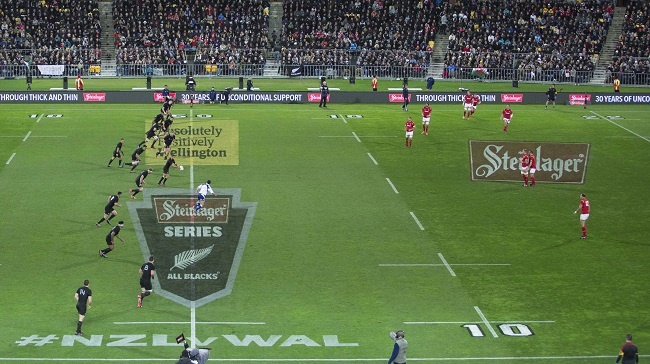- Rugby Toolbox
- Referees
- Referee Development
- Law Questions and Answers
- Law 12 Kick-off and Restart Kicks
- Law 1 The Ground
- Law 3 Team
- Law 4 Player's Clothing
- Law 5 Time
- Law 6 Match Officials
- Law 7 Advantage
- Law 8 Scoring
- Law 9 Foul Play
- Law 10 Offside and Onside in Open Play
- Law 11 Knock-on or Forward Pass
- Law 12 Kick-off and Restart Kicks
- Law 13 Players on the Ground in Open Play
- Law 14 Tackle
- Law 15 Ruck
- Law 16 Maul
- Law 17 Mark
- Law 18 Touch, Quick Throw and Lineout
- Law 19 Scrum
- Law 20 Penalty and Free Kick
- Law 21 In-Goal
Law 12 Kick-off and Restart Kicks

Law 12 Kick-off and Restart Kicks
1. When are kick-offs used?
Answer: To start each half.
2. When are restart kicks used?
Answer: To resume play after a score or touch down.
3. What type of kick is used for all kick-offs and restart kicks?
Answer: Dropped kick.
Sanction: the non-kicking team has the option of a re-kick or scrum.
Kick-offs and Restart Kicks Following A Score
1. Where are kick-offs taken from?
Answer: Behind the centre of the halfway line.
Sanction: the non-kicking team has the option of a re-kick or scrum.
2. Which team starts the second half?
Answer: The opponents of the team that kicked off in the first half.
3. After a team has scored, which team restarts play?
Answer: The non-scoring team on or behind the centre of the halfway line.
Sanction: the non-kicking team has the option of a re-kick or scrum.
4. When the ball is kicked, where must players be?
Answer: A. team-mates of the kicker must be behind the ball.
Sanction: scrum.
B. the opposition players must be on or behind their 10m line.
Sanction: the kick is taken again.
5. How far must the ball travel?
Answer: 10m.
Sanction: the non-kicking team has the option of a re-kick or a scrum.
6. If the ball reaches the 10m line but is blown back or if an opponent of the kicker plays the ball, what should the referee rule?
Answer: Play continues.
7. If the ball goes directly into touch, what should the referee rule?
Answer: Offer the non-kicking team the option of choosing A. a re-kick, B. scrum, C. lineout, D. quick throw.
8. If the ball is kicked into the opponents’ in-goal without touching a player and an opponent grounds the ball without delay or it goes dead, what should the referee rule?
Answer: Offer the non-kicking team the option of a scrum at halfway or a re-kick.
9. If the ball is kicked into the kicking team’s in-goal and is made dead by a defending player or it goes dead through in-goal, what should the referee rule?
Answer: Award the non-kicking team a 5m scrum.
Restart Kicks Following A Touch Down (22m Drop Out)
1. When is a 22m drop out awarded?
Answer: When after an attacking team player takes the ball into in-goal and a defender makes the ball dead?
2. How is a 22m drop out taken?
Answer: A. anywhere on or behind the 22m line
Sanction: scrum.
B. without delay.
Sanction: FK
C. the ball must cross the 22m line.
Sanction: the opposition has the option of a re-kick or a scrum.
D. the ball must not go directly into touch.
Sanction: the opposition chooses (i). re-kick, or (ii). a scrum, or (iii). a lineout, or (iv). a quick throw.
3. May an opponent of the kicker charge over the 22m line before the ball is kicked?
Answer: No.
Sanction: FK
4. May an opponent of the kicker who is inside the 22m area delay or obstruct the drop out?
Answer: No.
Sanction: PK
5. If the ball crosses the 22m line but is blown back, what should the referee rule?
Answer: Play continues.
6. If the ball does not reach the 22m line, can advantage apply?
Answer: Yes.
7. If a 22m drop out reaches the opposition in-goal without touching a player and it is grounded by an opponent without delay or it goes dead or touch-in-goal, what should the referee rule?
Answer: Offer the non-kicking team the option of a re-kick or a scrum on the kicking team’s 22m line.
8. Can the team-mates of the kicker be in front of the ball when it is kicked?
Answer: No unless it is taken quickly; in this case, those who are in front may be sanctioned unless they retire and do not interfere until they are put onside by their team-mates.
Sanction: scrum